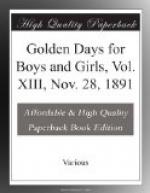134.—1. In military or naval parlance, a ration is a portion or fixed allowance of provisions, drink and forage, assigned to a soldier in the army or a sailor in the navy, for his daily subsistence. Its component parts are established by law, but may be varied by the Secretary of War or of the Navy; or, when necessary, by the senior officer present in command. The latter may also diminish the allowance, in case of necessity, but of course the persons whose allowance is thus lessened are reimbursed according to the scale of prices established at the time of such diminution. 2. The regulation chest measurement required of a seventeen-year-old applicant for admission on a training-ship is 29 inches.
F.B.H., MIDSHIPMAN and W.H.E.—1. As there are but two schoolships in the United States, and none but New York and Pennsylvania boys are admitted on them, non-residents’ applications for enlistment would not be considered under any circumstances. Boys desiring to enter the U.S. navy can do so by enlisting on a training ship, which is a government institution, and intended as a means of fitting our youth to perform the duties of sailors and petty officers in the regular navy. The schoolship boys, on the other hand, are trained for the merchant service. The Chief of the Bureau of Equipment and recruiting, Navy Department, Washington, D.C., is the one to whom all applications for enlistment on the training ships should be made. 2. No premium is offered for U.S. pennies coined in 1858.
GENERAL NAPOLEON.—1. A graduate of the schoolship Saratoga might be able to obtain an appointment as quartermaster on an ocean steamship at a salary of about $30 per month. The other officers on these vessels are shipped on the other side of the Atlantic, and have to show a certificate of service before being appointed as mates or to any other official position. The schoolship boys should experience but little trouble in getting some minor berths on coastwise vessels or other crafts sailing under American colors. The chief idea in establishing the two schoolships, St. Mary’s and Saratoga, was to fit boys for the mercantile marine, and probably, if ever the trans-Atlantic liners sail under our flag, they will be given appointments on them. 2. The pay of the officers on steamship lines varies so greatly that no general average can be given.
CURIOUS READER.—1. There are several colleges in this country in which poor boys are afforded an opportunity of putting into practice legitimate plans for raising sufficient money to pay for tuition and other expenses. This subject was treated of in a very interesting and instructive article entitled “Working One’s Way Through College,” in No. 15 of the volume just ended. In it will be found many such plans, which will prove of great benefit to those intending to thus gain a collegiate training. 2. The Constitution does not require candidates for government positions to possess a college education—in fact, comparatively few heads of departments, commissioners, etc., are thus equipped. 3. There are no “free trade” colleges in the United States. We do not know of the existence of such institutions in any part of the world.




